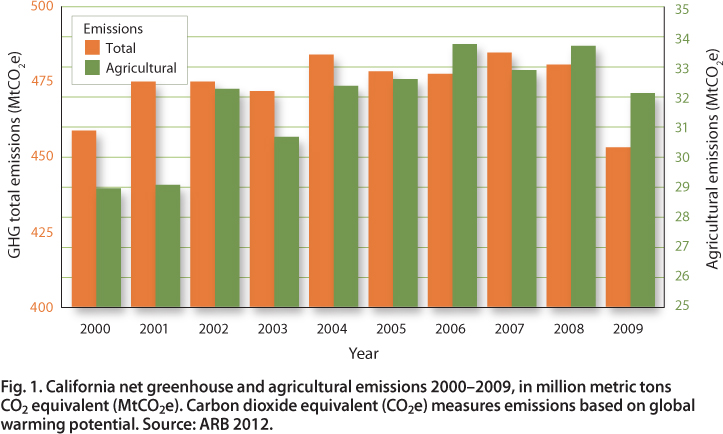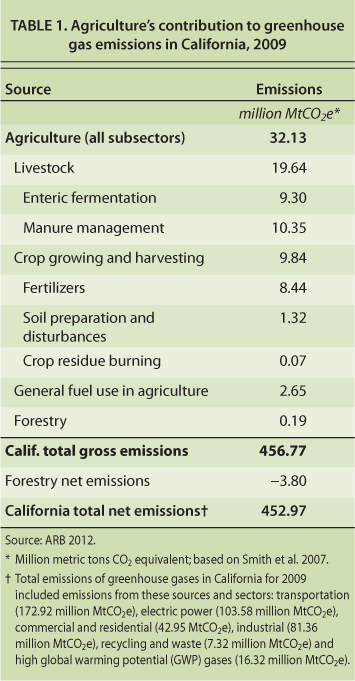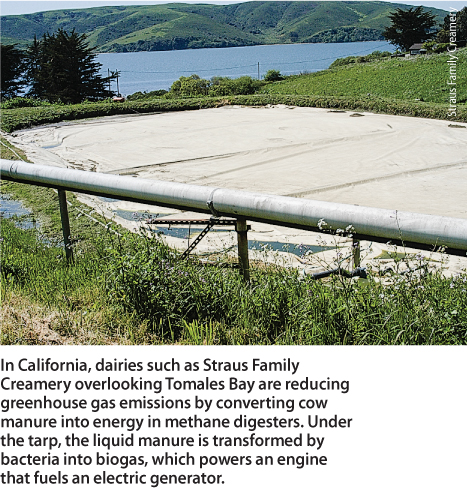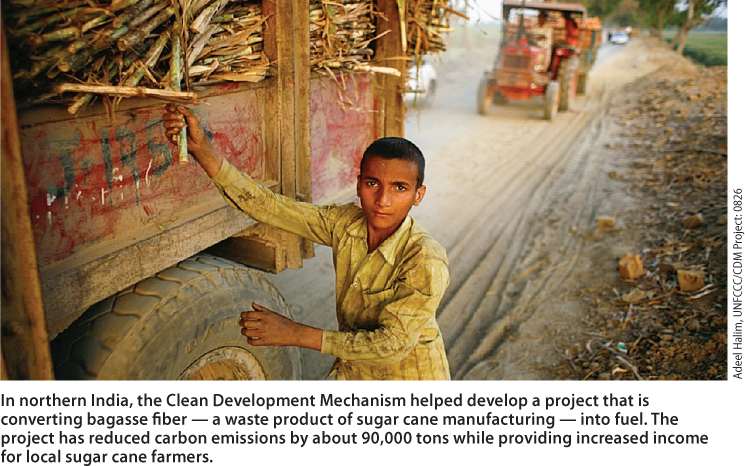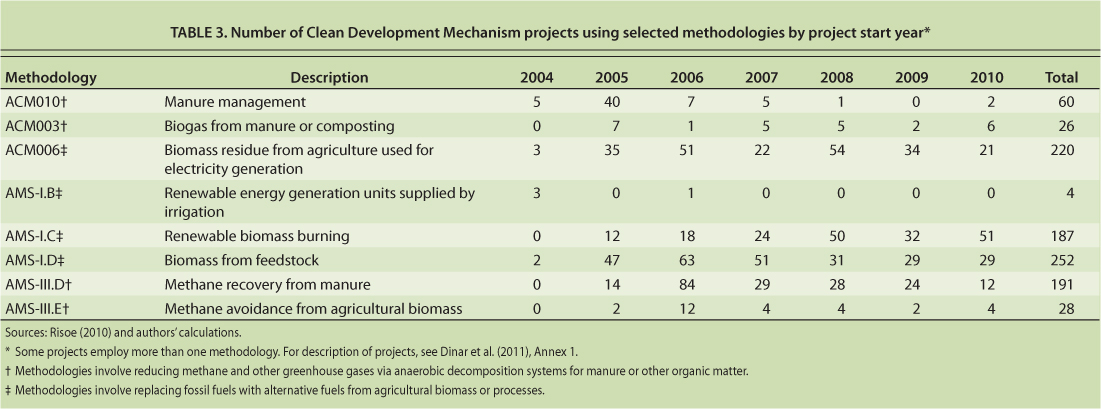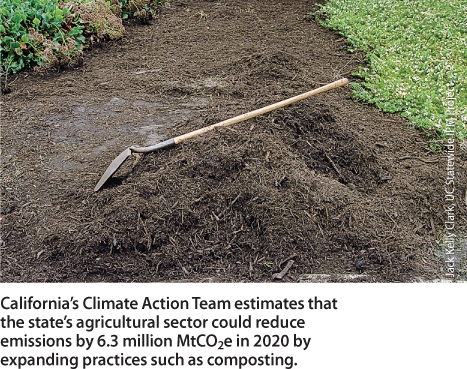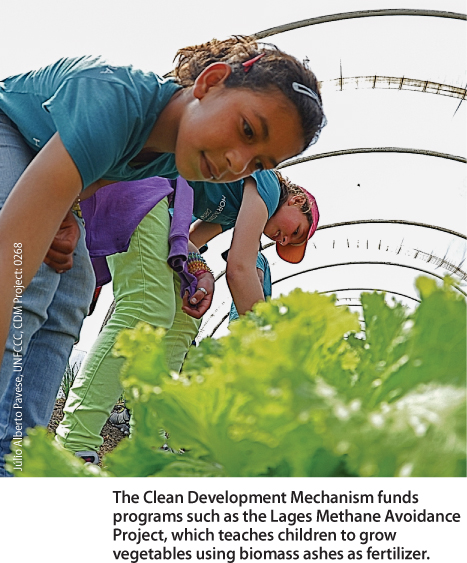All Issues
Clean Development Mechanism agricultural methodologies could help California to achieve AB 32 goals
Publication Information
California Agriculture 66(4):137-143. https://doi.org/10.3733/ca.v066n04p137
Published online October 01, 2012
NALT Keywords
Abstract
California Assembly Bill 32 (AB 32), passed in 2006, mandates reductions in California's greenhouse gas emissions to 1990 levels by 2020. Charged with implementing the bill, the California Air Resources Board has identified emission reduction strategies, including nine for agriculture. The goals set for agriculture are voluntary, but because the agricultural sector represents a significant portion of both the state's economy and its greenhouse gas emissions, it offers considerable opportunities for mitigation activities. To reduce compliance costs, the Board's plan includes a cap-and-trade program that allows for offsets to be purchased from nonregulated firms that undertake mitigation in or outside the state. However, methodologies are needed to assess the impact of mitigating activities. Without them, emission reductions are expected to fall far short of potential. We review an existing international mechanism — the Kyoto Protocol's Clean Development Mechanism (CDM) — that offers a framework for evaluating offset projects and advanced methodologies that could facilitate AB 32 implementation in California.
Full text
Greenhouse gas emissions change in response to population and economic growth. Net emissions in California rose between 2000 and 2004 from 459.2 to 484.0 million metric tons of CO2 equivalent (million MtCO2e) before declining to 453.0 million MtCO2e in 2009 as the economy slowed (ARB 2012) (fig. 1). Agricultural emissions, as a fraction of total net emissions, are also gradually increasing, from 6% in 2000 to 7% in 2009.
The U.N. Clean Development Mechanism promotes projects that reduce greenhouse gas emissions in developing countries. Its methodologies can help inform the implementation of California's AB 32. Above, crop material is transported for processing as biofuel in Marrakesh, Morocco.
Fig. 1. California net greenhouse and agricultural emissions 2000–2009, in million metric tons CO2 equivalent (MtCO2e). Carbon dioxide equivalent (CO2e) measures emissions based on global warming potential. Source: ARB 2012.
In 2006, the California legislature passed Assembly Bill 32 (AB 32), the Global Warming Solutions Act of 2006 (ARB 2006), which requires California to reduce greenhouse gas emissions to the 1990 level of 427 million MtCO2e by 2020. This amounts to a 15% reduction in 2008 levels and a 30% reduction in levels that would occur by 2020 if no actions were taken. AB 32 directs the California Air Resources Board (ARB) to develop a plan for reducing greenhouse gas emissions, which the agency completed and made available for public comment (ARB 2008, 2010a). The plan identifies emission reduction strategies targeting emission sources for different sectors; nine focus on agriculture (CAT 2008). The reductions are mandatory for some sectors, such as industrial enterprises and electrical power operations, but for agriculture they are voluntary.
Agriculture represents a significant economic sector in California; it uses 25% of the state's land and consumes about 75% of its water resources (Hanak et al. 2011; USDA 2007). California agriculture produced approximately $34.8 billion in revenue in 2010 (Agricultural Statistical Review 2010) and ranks number one among states in agricultural cash receipts (CAT 2008). In terms of greenhouse gas emissions, agriculture accounted for about 7.1% of California's total in 2009 (table 1).
What is a metric ton of carbon dioxide?
Driving from Los Angeles to Washington, D.C. — assuming that a full tank of gasoline yields an average of 300 miles — produces the equivalent of about 1 metric ton of carbon dioxide (MtCO2e) in emissions (Ha 2012).
Cap-and-trade program
The Air Resources Board plan for achieving AB 32 goals includes a combination of direct regulations, performance-based standards and market-based mechanisms. The centerpiece is a cap-and-trade program, which would initially target certain production or distribution processes, including cement production, oil refining, and other significant users of fossil fuels. The program is designed to potentially be linked to similar programs, in particular to an envisioned regional cap-and-trade program that includes New Mexico, British Columbia, Quebec and Ontario.
Under California's proposed cap-and-trade program, regulated firms would be given allowances for greenhouse gas emissions once a year beginning in 2012, declining 2% to 3% per year to match emission reduction targets. Firms with surplus allowances could sell or save (bank) them for future use. Firms unable to reduce their emissions or looking to increase emissions could enter the market to purchase surplus allowances (ARB 2010a).
These trading features of the proposed program (LAO 2012) are standard components of cap-and-trade systems, including those pioneered in California to reduce air pollution (Larson and Parks 1999). The Board's proposed program is also innovative because it would be open to additional private or public mitigation activities that reduce emissions or sequester greenhouse gases. Firms or groups in noncapped sectors may undertake mitigation activities and then be credited with offsets. Regulated firms can buy these and use them in lieu of government-issued allowances to meet a portion of their regulatory requirements (ARB 2010b). Firms in capped sectors could also theoretically undertake mitigation activities beyond their quota, depending on their marginal abatement cost.
Trading under the cap, and potentially supplementing allowances with offsets, are both expected to reduce compliance costs, an objective of the Board's plan. The two mechanisms are complementary: trading creates price signals that motivate regulated firms to seek low-cost mitigation opportunities, and the opportunity to earn credits that can be sold encourages regulated and nonregulated firms and groups to seek low-cost mitigations in sectors where emissions are not capped.
To work, the program requires a comprehensive set of standards and regulations that details how emissions are measured and offsets created, especially if it is to be part of a regional cap-and-trade system. The standards and regulations must rigorously protect the environmental benefits associated with emission reductions, because regulated emitters have incentives to under-report emissions, and both buyers and sellers of offsets benefit from exaggerated mitigation claims (Chomitz 1999). Initially, the Board plan envisions four sets of rules, called compliance offset protocols, for offset-generating projects, including one for livestock projects.
Livestock production is the agricultural subsector with the highest emissions and in turn with the highest potential for mitigation (table 1). It uses approximately 37% of the state's agricultural land (USDA 2007), and it generated 61% of California's agricultural greenhouse gas emissions in 2009. The remaining 63% of agricultural land is used for field, fruit and nut crops; these crops generated 30% of the state's agricultural emissions in 2009 due to fertilizer use, soil preparation and disturbances, and the burning of crop residue. Fuel used for agricultural activities contributed the remaining 8%.
Since agriculture represents a significant portion of both the state's economy and greenhouse gas emissions, it is not surprising that it offers considerable mitigation opportunities. The Climate Action Team (CAT), the government agency responsible for implementing California's global warming emission reduction programs, estimated that agriculture's annual greenhouse gas emissions could be reduced by 9.1 million MtCO2e per year if the emission reduction strategies were fully implemented (CAT 2006, 2008).
Nine strategies for agriculture
The mitigation potential for agriculture is comprised of nine strategies, each of which contains identified activities for implementation (table 2). The most significant strategies concern the uses of biomass: Converting manure to energy could generate annual reductions of 1 million MtCO2e and using other types of agricultural biomass another 2.3 million MtCO2e.
Other important strategies concern carbon sequestration. When plants photosynthesize, they remove carbon dioxide from the atmosphere and convert it into organic carbon, which is used in the production of plant biomass; for example, leaves, wood, roots or root exudates. When leaves fall, roots secrete or plants die, this carbon can be removed from active cycling and stored, or sequestered, in the soil if it is protected from microbial decomposition (Jastrow et al 2007). Consequently, carbon sequestration can be achieved by farmscaping — planting trees, shrubs and grasses in hedgerows, which removes carbon dioxide out of the atmosphere and contributes to the formation of soil complexes that fix carbon. Carbon sequestration in soils and plants could save 2.5 million MtCO2e — 1.5 million MtCO2e from farmscaping (CAT 2008) and another 1.0 million MtCO2e in soils (table 2).
Although the Board proposed a livestock protocol and rules on fuel use that might support several strategies, significant hurdles prevent implementation of many of the strategy activities. In its AB 32 analysis, the Climate Action Team noted that methodologies for more than half of the agricultural strategies were not in place, in part because of a lack of scientific research (CAT 2008). This situation accounts for much of the difference — approximately 25%, or 2.8 million MtCO2e — between potential reductions for 2020 if the strategies were implemented and reductions deemed feasible by that year (table 2).
The Clean Development Mechanism
The challenges facing the Air Resources Board are not completely uncharted. There has been considerable experimentation on how to structure agricultural projects that reduce emissions or sequester carbon, beginning with voluntary pilot projects under the auspices of the United Nations (Larson and Breustedt 2009). Particularly relevant are thousands of projects operating under the Clean Development Mechanism, which promotes technology transfer and private and public investments in emission reduction and sequestration projects in developing countries.
The Clean Development Mechanism is a project-based provision of the Kyoto Protocol, an international agreement linked to the U.N. Framework Convention on Climate Change (UNFCCC), which aims to reduce greenhouse gas emissions and enhance welfare in developing countries. Credits generated by these projects can be used to meet pledged emission reduction commitments under the UNFCCC. The structure is analogous to the California Air Resources Board's proposed program, which allows independent entities to create offsets that regulated firms can use. For example, since agriculture is an unregulated sector under the California program, a livestock farmer could potentially capture livestock methane emissions, receive offset credits for the voluntary emission reduction, and in turn sell them to a regulated entity such as a concrete manufacturing facility in need of additional carbon allowances. Central to the Clean Development Mechanism are its technical blueprints, called methodologies, which lay out rules for calculating the number of credits granted for specific mitigation activities.
Overall, the Clean Development Mechanism has successfully attracted project investments (Rahman et al. 2010), though it has been more effective in some agricultural mitigation activities than others (Larson et al. 2011). Agricultural mitigation projects, those that convert organic waste products to energy and limit methane emissions, have been successful under the Clean Development Mechanism, but land-use projects have not been successful under the Clean Development Mechanism in its current form. Land-use projects are defined as the total human arrangements, activities, and inputs undertaken in a certain land cover type to achieve purposes for which land is managed, such as crop production, grazing, timber extraction and conservation. Land-use forestry projects are those associated with decreasing emissions through avoiding deforestation, improving forest management and increasing the uptake of carbon (IPCC 2000). The Clean Development Mechanism has an extensive agricultural project base with a set of established standards and rigorous, peer-reviewed methodologies to ensure that the offsets are real, additional and verifiable (UNFCCC 2010).
In California, dairies such as Straus Family Creamery overlooking Tomales Bay are reducing greenhouse gas emissions by converting cow manure into energy in methane digesters. Under the tarp, the liquid manure is transformed by bacteria into biogas, which powers an engine that fuels an electric generator.
This large stock of already completed methodologies can provide guidance as the Air Resources Board and Climate Action Team develop California's implementation rules and protocols. In particular, it could hasten their progress by providing methods of quantification for particular processes that would otherwise need extensive research. For example, one of the hurdles for implementing farmscape sequestration is uncertainty about its potential to sequester carbon and whether this potential is significant enough to merit the development of a measurement methodology (CAT 2008). In addition, the analysis cites the difficulty in quantifying the carbon content of woody shrubs as an obstacle to including the simple practice of planting shrubs in hedgerows between crops as an AB 32 strategy.
The Clean Development Mechanism has an approved baseline and monitoring methodology (AR-AM0006) for reforestation and afforestation, defined as the establishment or re-establishment of forest cover (Zomer et al. 2008). And it has researched the carbon sequestration potential of planting trees and shrubs in hedgerows and states that the resulting carbon pools are significant (CDM 2006). The methodology contains equations for woody shrubs as well as equations for measuring net greenhouse gas removal by sinks, another scientific hurdle mentioned by the Climate Action Team in regard to implementing agricultural carbon sequestration projects (CAT 2008).
In northern India, the Clean Development Mechanism helped develop a project that is converting bagasse fiber — a waste product of sugar cane manufacturing — into fuel. The project has reduced carbon emissions by about 90,000 tons while providing increased income for local sugar cane farmers.
Soil carbon dynamics is an ongoing research topic, and its biological and physical mechanisms are not well understood (Post and Kwon 2000), but the Clean Development Mechanism project methodologies could help California realize its 2020 regulatory targets. Agricultural projects in the Kyoto Protocol include implementation opportunities and solutions to hurdles that are relevant to tapping mitigation potential in California agriculture.
How the CDM works
Those charged with implementing AB 32 must find instruments that are both economically efficient and environmentally effective. In the case of the Clean Development Mechanism, environmental integrity is subject to specific supervision rules and a series of checks along the project cycle by the UNFCCC Secretariat. To start, an international supervisory group, known as the CDM Executive Board, must approve methodologies for establishing baselines on behalf of the UNFCCC. Approved methodologies are published, and project developers can consult them. However, projects relying on new methods face the additional task of gaining approval. In either case, whether new or established methods are employed, developers must also convince the CDM Executive Board that their project methodology has been appropriately applied.
The project cycle also contains checks carried out by an independent firm or organization that has been accredited by the CDM Executive Board. This entity, known as a designated operational entity (DOE), initially validates the baseline design and the project's plan to monitor and measure outcomes. This occurs before the project is registered — that is, officially recognized by the CDM Executive Board. For large projects, a separate independent entity carries out the project's monitoring protocol, the process by which emissions or sequestrations are measured.
CDM agricultural projects
In the context of the Clean Development Mechanism, we define an agricultural project as one that uses agricultural residuals, outputs or processes to directly or indirectly reduce greenhouse gas emissions (FAO 2010). This includes projects that sequester carbon in soils.
We studied a dataset described by Larson et al. (2011) that covers 5,824 projects (as of Dec. 1, 2010), based on data reported by Risoe (2010). Of these, 1,022 projects (17.5%) were classified as agricultural, land-use or forestry projects. Examples of such projects include the Assisted Natural Regeneration of Degraded Lands in Albania (World Bank 2009, 2011) and the Moldova Soil Conservation Project (World Bank 2004, 2011). The Albania project was designed to transform badly eroded lands into broadleaf forests of native species. The primary objective of the project in Moldova is to conserve and improve the productivity of agricultural soils by planting shrubs and trees. The project is expected to generate other benefits, including global biodiversity and fuelwood and other forestry products for nearby communities.
Based on Risoe's analysis, the agricultural projects are expected to reduce business-as-usual emissions by nearly 220 million MtCO2e by 2012 and 582 million MtCO2e by 2020. Available estimates of CO2 emissions (WRI 2011) suggest that total global annual emissions were 30.0 and 37.8 GtCO2e (1 gigaton [Gt] CO2e = 1 billion metric tons CO2e) in 1990 and 2005, respectively.
The main methodologies used for these 1,022 projects were extracted from Risoe's project data and can be found in Dinar et al. (2011). The projects rely on 33 approved methodologies (Larson et al. 2011), but the eight most frequently used methodologies account for 80% of the projects (table 3). While each project must meet the specific criteria stated in each methodology, a closer look at the most widely used methodologies suggests that they are composed of variations around a small set of core mitigation activities.
TABLE 3. Number of Clean Development Mechanism projects using selected methodologies by project start year*
The most widely used mitigation activity displaces fossil fuels with alternative fuels from agricultural biomass or processes. Examples include the generation of electricity by burning agricultural waste and the generation of mechanical energy via irrigation. The second most widely used mitigation activity is avoiding the release of methane and other greenhouse gases, or recovering them by modifying anaerobic decomposition systems for manure or agriculturally derived organic matter (Dinar et al. 2011, Annex 1).
These two core mitigation activities already in place on a number of the state's farms could be adopted in California. They would encourage better management of manure, as well as the displacement of fossil fuels. However, Clean Development Mechanism methodologies are less well developed in areas associated with other important AB 32 strategies, including crop growing and harvesting, and soil preparation and disturbances. Consequently, methodological hurdles will remain in the short run, making it difficult to tap mitigation opportunities in these areas.
Mitigation potential
Missing methodologies are also holding back international mitigation efforts. The Clean Development Mechanism taps only a small portion of the mitigation potential in the agricultural sectors of developing countries. For example, Larson et al. (2011) calculated that the 1,022 agricultural and land-use forestry projects studied amounted to a little more than 3% of the mitigation potential identified in the most recent Integovernmental Panel on Climate Change (IPCC) report (Smith et al. 2007). Larson et al. (2011) note several generous assumptions in their calculations and surmised that their estimate represents an upper bound.
In the case of the Clean Development Mechanism, much of the mitigation gap likely arises from missing methodologies for land-use projects. Mitigation activities for these projects include the restoration of degraded land, better management of crop and pasture land, and the appropriate use of fertilizers. Research summarized by the Intergovernmental Panel on Climate Change (Smith et al. 2007) suggests that these activities have the largest mitigation potential for the agricultural sector globally and thus for achieving AB 32 goals as well.
Land-use projects
The appropriate roles for land-use projects in international mitigation efforts were contentiously debated as the Kyoto Protocol and the Clean Development Mechanism were crafted (Larson et al. 2008). And, in the rules that eventually emerged, the projects faced special limitations, in large part because of the nature of land-use mitigation. The activities are mostly straightforward and readily observed, for example, the adoption of conservation tillage methods or the addition of organic material to degraded soils. The likely benefits and processes generating them are easy to list as well. But measuring precisely the net effects, which are needed to assign credits, is challenging, and the related science is complex. Moreover, even well-measured effects are potentially reversible under many settings. For example, the mechanisms controlling soil organic carbon (SOC) dynamics are imperfectly understood (Sollins et al. 1996), so even meticulously inventoried carbon stocks have the potential to be re-emitted back into the atmosphere if temperature, precipitation or any other of the myriad variables affecting soil organic carbon dynamics happen to change. This difficulty creates skepticism about the environmental integrity of land-use projects and increases monitoring costs, which encourages potential investors to favor alternative projects.
California's Climate Action Team estimates that the state's agricultural sector could reduce emissions by 6.3 million MtCO2e in 2020 by expanding practices such as composting.
The Clean Development Mechanism funds programs such as the Lages Methane Avoidance Project, which teaches children to grow vegetables using biomass ashes as fertilizer.
Land-use projects fit uneasily in an offsets framework for another reason, which concerns their positive externalities (spillover benefits not reflected in price and affecting outside parties). In some cases, they generate important environmental benefits (cobenefits) in addition to benefits that are part of the mitigation plan. For example, landscape management practices that reduce soil erosion build up pools of carbon sequestered in stabilized soil, a mitigation activity that could be part of an offsets program; but the mitigation also can lead to cleaner streams, giving better protection to watersheds and cleaner water for downstream consumers. When public cobenefits are significant and entail additional cost, assigning credits for sequestration activities alone may not be sufficient incentive to encourage investors. Ideally, program incentives would be sufficient to promote the production of both mitigation benefits and public cobenefits. In the Clean Development Mechanism, payments are based on mitigation outcomes, and co-benefits are not financially rewarded. A further disincentive to investors is that coordination among landowners is often needed to fully capture land management benefits, which can drive up transaction costs.
Project-based mitigation works well on a global scale for certain types of agricultural projects, mostly those that manage organic wastes or use byproducts to produce energy. Land-use projects are less suitable due to the complex and location-specific biochemistry of carbon sequestration in soils, the frequent need to coordinate actions across a large number of landowners and the additional complication of accounting for cobenefits.
Implications for California
The Clean Development Mechanism offers encouraging lessons for the implementation of AB 32. First and foremost, it shows that when combined with emission caps and markets in tradable allowances, offset programs can provide incentives for private and public investment in mitigation activities. Second, some of the agricultural mitigations envisioned by the Air Resources Board are practicable. And third, the methodologies that have been built up in recent years in the Clean Development Mechanism could help accelerate the establishment of AB 32 protocols.
Other lessons concern the future inclusion of California's cap-and-trade program into a regional program. Current rules preclude California cap-and-trade program participants from trading in carbon reduction credits with non-U.S. producers. However, the Air Resources Board notes that projects outside of California can help lower the compliance costs for regulated entities in California, and they can reduce greenhouse gas emissions in regions that would otherwise lack the resources for such projects. The Board refers in particular to projects along the Mexican border as potentially benefiting both California and Mexico (ARB 2008). Building on Clean Development Mechanism methodologies already in use in Mexico could smooth a regional expansion of the California program.
Furthermore, the trading and offset provisions of the proposed California program are designed to contain the costs of meeting emission reduction objectives, and the Clean Development Mechanism could provide important guidance and inspiration for their implemetation. Broadly speaking, the effects of carbon emissions on climate are the same regardless of where the emissions occur, which is why some countries have used Clean Development Mechanism offsets in other countries to supplement their own mitigation activities. For example, the European Union's Emission Trading Scheme allows firms to meet a portion of their regulatory requirements with Clean Development Mechanism credits, though that arrangement terminates this year, and the future is not clear.
If project-based crediting continues under the UNFCCC, as many expect it will, the California system could be opened, partly or fully, to UNFCCC tradable offsets as a way to contain costs. And to the extent that lower-cost emission reductions could be found in other countries, the California system could have a larger impact on climate change for a given cost.
The Clean Development Mechanism offers a few off-the-shelf methodologies for quantifying the impact of land-use projects, but more scope remains for California to develop a soil sequestration protocol of its own. The UNFCCC has moved recently to create incentives that slow deforestation, but similar mechanisms to protect carbon pools in soil are still missing. To make progress in the farmscape and soil carbon sequestration strategies, California must find a way to fit land-use project incentives into future protocols or devise other instruments.
Prospects for California agriculture
For California to meet its 2020 emissions reductions targets, the Market Advisory Committee (MAC) to the California Air Resources Board recommended a phased approach, in which standards would be set for an initial group of offset categories around which there was a high degree of confidence in their environmental integrity (MAC 2007). For out-of-state offsets, California would sign contracts with other states or countries to adequately ensure a similar level of environmental integrity and accountability.
Agriculture is an important sector of California's economy with much untapped potential for carbon offsets. The Economic and Technology Advancement Advisory Committee (ETAAC) was formed to advise the Air Resources Board on activities that will facilitate investment in and implementation of technological research and development opportunities. ETAAC identified the technical potential to derive about 17 million MtCO2e of climate change mitigation benefits from California production agriculture, which is about 10% of the total goal for 2020 (ETAAC 2008, Table 6–1).
The Market Advisory Committee's call for working with other regions or countries — perhaps developing ones — to invest in agricultural projects opens a window of opportunity for cost-effective carbon abatement. The Clean Development Mechanism provides a framework for organizing offset projects and methodologies to assess their impact. Within the agricultural sector, it has been an effective conduit for mitigation projects backed by private and public funding that use residual agricultural organic matter as an alternative fuel source, as well as those that manage methane from composting and manure.
Strategies for using the CDM
How can California become a player in this arena and use the Clean Development Mechanism to its immediate advantage? ETAAC (2008) suggests several strategies that could also be applied in a Clean Development Mechanism context. One is to identify and provide financial incentives for the low-hanging fruits (“early action” areas) with credits that can be clearly defined. Agriculture is considered an “early action” area. Another strategy calls for the creation of a trust for public funding, which would direct investments in research, development and demonstration (RD&D) and finance technology pilot projects. Another strategy calls for fostering international and domestic collaborations to learn from others who have already implemented climate change policies (ETAAC 2008).
Our work suggests that California could benefit from reviewing the existing Clean Development Mechanism methodologies and adapting them for its specific needs. In addition, California could create policies and rules that reflect the true value of land-use carbon credits, which in turn would provide incentives for investors to engage in agricultural land-use projects.




